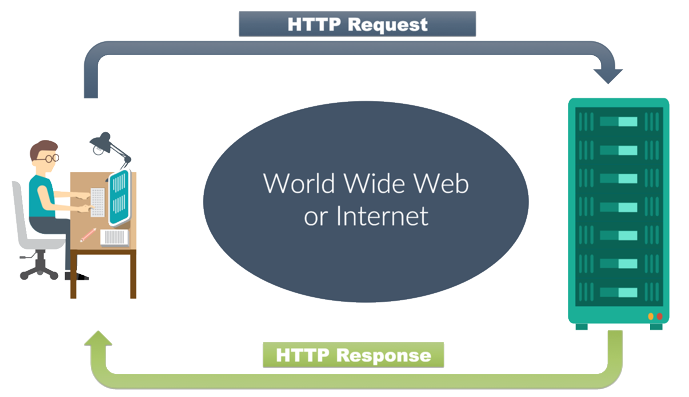HTTP stands for HyperText Transfer Protocol. This is a basis for data communication in the internet. The data communication starts with a request sent from a client and ends with the response received from a web server.
- A website URL starting with “http://” is entered in a web browser from a computer (client).
- Browser sends a request sent to the web server that hosts the website.
- The server then returns a response as a HTML page or any other document format to the browser.
Request–response is one of the basic methods computers use to communicate with servers. A computer sends a request for some data and the server responds to the request. Usually, there is a series of such interchanges until the complete message is sent; browsing a web page is an example of request–response communication.
We refer to ‘users’ as using Browsers or Clients.
Clients make requests.
Servers make responses and send them back to the browser.
Browsers render views of web pages based on data received by a servers response.
Request–response can be seen as a telephone call, in which someone is called and they answer the call.

In Sinatra a route is an HTTP method paired with a matching URL-matching pattern.
Each route is associated with a block.
The two most common HTTP methods for sending requests are:
- The GET request is used to request data from a specified resource.
- The POST request is used to send data to a server to create/update a resource.
get '/' do
.. show something ..
end
post '/' do
.. create/update something ..
end
When a URL is inputted, the browser sends a GET request to a web server. When a form is submitted on a website, a POST request is submitted, and the browser hands off the form data to be handled by the server.
POST requests send data to a server, which then send a response as a view rendered in HTML back in the browser.
Let’s say you have an app that has a “signup” button on the landing page. When a user clicks on the “signup” button, the browser will use the GET method to send a request for a form to the server. The server will send back a responce which will render a view in HTML of a form that the user can fill in. When the user clicks on a “submit” button, the client will then use the POST method to send that data to the server where it will be processed.

Some other notes on GET requests:
- GET requests can be cached
- GET requests remain in the browser history
- GET requests can be bookmarked
- GET requests should never be used when dealing with sensitive data
- GET requests have length restrictions
- GET requests is only used to request data (not modify)
Some other notes on POST requests:
- POST requests are never cached
- POST requests do not remain in the browser history
- POST requests cannot be bookmarked
- POST requests have no restrictions on data length